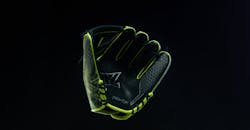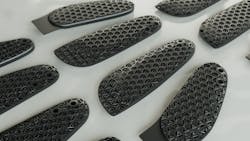List of Manufacturers Playing Ball With Additive Keeps Growing
Fast Radius recently partnered with sporting goods giant Rawlings and additive technology provider Carbon to produce the new REV1X baseball glove.
The new glove uses an intricate lattice design in the pinky and thumb inserts. Leveraging Carbon digital light synthesis (DLS) 3D printing, the lattice is lightweight and flexible without sacrificing protection or durability representing a significant evolution in glove design.
The goal was not only to improve major league players’ defense on the field, but to eventually give all baseball fans and players access to this significant improvement in equipment technology, explains John Nanry, chief manufacturing officer and co-founder of Fast Radius.
“After prototyping the REV1X lattice inserts using Carbon’s DLS process, Rawlings needed a way to scale this complex part to mass production. Because speed was key with this project, Rawlings wanted to be able to iterate new inserts quickly based on real time feedback from players,” says Nanry.
Nanry tells IndustryWeek, the success of the Rawlings project further demonstrates the possibilities existing for additive within the sporting goods sector. “We’ve already seen amazing results for foam replacement in applications like football helmets, bike seats and shoes. In each of these cases, additive has improved the performance and safety of these products. We’ve also done some work with stiff, flexible elastomers that could have major implications for sporting goods,” he says.
Because HP's multi jet fusion does not require support structures, current technology opens the door to printing geometries that were not possible with previous additive elastomers. “For example, TPA allows us to make an entire shoe in a single print,” he says. “It’s not possible to print a shoe with an enclosed upper section using a method that requires support structures, but HP MJF technology doesn’t pose that limitation.”
However, rapid product development was the star in this project. Fast Radius was able to collaborate with the Rawlings team to iterate quickly by changing the CAD files and testing the outcomes. “We were able to develop and unlock new ideas fast — ideas that we wouldn’t have had the time to explore if not for using AM,” says Nanry.
Of course, scaling wasn’t as simple as just printing more inserts to meet Rawlings’ needs, especially because FPU can be tricky to post-process, explains Nanry. “Our team had to dial the printing process and develop custom post-processing methods to meet tight tolerances needed for the lattice structures,” he says. “Lattices like these are difficult to measure, we also had to come up with new ways to qualify these parts to ensure repeatability. Ultimately, our efforts throughout the production process improved part yield by more than 4x from the initial tests we did with Rawlings.”
Expanding applications for additive
Fast Radius also recently worked with Aptiv and Ford Motor Co. to produce a delete cap to close off all of the electronics on Ford's F350 pick-up truck for customers who did not want the tow package. When embarking on the project, additive was the choice for a number of reasons with the main being economics. The estimated annual volume for these was about 20,000.
"At that volume, additive ended up being cheaper to produce than it would have been tooling up to produce a molded part. With electrical connectors in particular, the tooling can be very expensive because they're very small, precise, and fine detail parts," he says.
The other primary reason was speed to market.In this case, the time from initial discussion through to production qualification took 20 weeks including various design iterations.
As the adoption of additive continues, the materials qualification process is still a major hurdle. "These large OEMs have a material set that's qualified and ready to go, and there's a fixed cost to qualifying material. The part was the first created by an external supplier using additive manufacturing to qualify a part through the PPAP process. The PPAP process has a reputation of being very challenging, and very rigorous," he says. "It was a great opportunity to work collaboratively to understand how a production-oriented qualification process could apply to additive."
Continued growth opportunities
With the supply chain disruptions and the increased appetite for reshoring, Fast Radius has seen a growing interest in additive processes, and companies accounting for the full costs of the supply chain risk.
"It can be a challenge when companies are focused on the lowest piece part price possible. While additive might have a higher piece part price, when you consider fixed costs like tooling and shipping, companies can end up with a you know a lower total cost of ownership using additive," Nanry says. "More companies are deploying the next wave of R&D spending, which is leading to added excitement around qualifying new materials to create existing products.”
About the Author
Peter Fretty
Technology Editor
As a highly experienced journalist, Peter Fretty regularly covers advances in manufacturing, information technology, and software. He has written thousands of feature articles, cover stories, and white papers for an assortment of trade journals, business publications, and consumer magazines.

